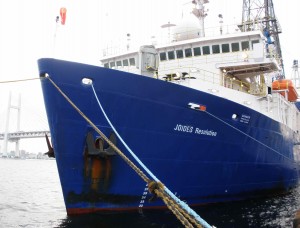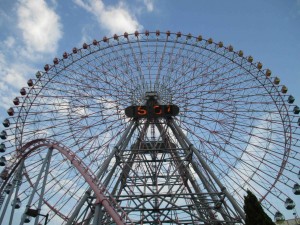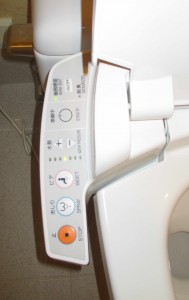A BEGINNING
Over the next two months I will be blogging about sailing on the vessel JOIDES Resolution (JR) as a member of the science party on the Integrated Ocean Discovery Program’s (IODP) Expedition 352 to the Izu-Bonin-Mariana Forearc.
Phew. That’s a mouthful. Let’s try and make it simpler.
What is the “Integrated Ocean Discovery Program” (IODP)? The IODP is an international effort to explore the sediments and rocks that make up the ocean floor through scientific drilling. A vast number of nations participate, inviting applications from researchers on a competitive basis to sail on expeditions which generally last 8 weeks. The number of country berths on an expedition is proportional to the financial contribution of the country, with the two driving forces being the USA and Japan. Europeans are also involved, and on 352 there are three UK-based participants. I could never do justice to the many ways in which IODP research has transformed Earth Science and encourage a quick read through the ‘Exploring our Planet’ section of their website: http://www.iodp.org
What is the point of Expedition 352? I could parrot back our cruise objectives, which are found in our Scientific Prospectus available from the Expedition webpage: http://iodp.tamu.edu/scienceops/expeditions/izu_bonin_forearc.html. However, perhaps the title of this blog can be usefully employed instead.
Crustal Death and Rebirth in the Pacific Ring of Fire is a title with a lot going on. The main focus of Exp 352 is a process called subduction, where one tectonic plate collides and sinks beneath another. Subduction consumes the downgoing plate, thus resulting in some ‘crustal death’. Many are familiar with the term ‘Ring of Fire’ (as it relates to geology, not the Jonny Cash song). Geologically speaking, the Ring of Fire comprises explosive subduction-induced volcanoes rimming the Pacific Ocean, including those found in Japan and the west coast of the United States. These volcanoes create new crust to live and work on, thus the ‘rebirth’. What Exp 352 investigates how and why subduction starts. We hope to recover a geologic record of the first magmatic (lava) products of subduction in the Bonin forearc. We know subduction started around 50 million years ago in the region and determining the chemical make-up of these first lavas will help enormously to test competing models of how subduction starts.
Who am I? I am a lecturer in geology at Imperial’s department of Earth Science and Engineering: http://www3.imperial.ac.uk/people/j.prytulak. I research igneous petrology (i.e. lavas and where they come from) and geochemistry (i.e the chemistry….of rocks). I sailed on the JOIDES Resolution in 2009 on IODP Exp. 324 to the Shatsky Rise – a “large igneous province” in the Pacific Ocean. This is my first attempt to ‘blog’, so expect some level of incompetence.
What is this blog about?
I am constantly impressed by the quality and dedication of our education officers, who sail with us, in communicating science to the public. For example, check out the initial post of 352’s education officer, Amy West: http://newswatch.nationalgeographic.com/2014/07/18/going-on-a-rock-cruise/
Thus instead of (poorly) re-inventing the wheel, I’ll stick with what I (should) know – the life of a science party member. I’ll convey how we go about meeting our expedition goals through recounting day-to-day experiences. And I’ll try not to be too dull. No promises.
Entry One
PORT CALL: Yokohama, Japan
“Port call” is where all wide-eyed scientists meet each other – many for the first time – to finish our logistical and mental preparations to sail.
The life of a science party member begins much the same as any international traveller. They are first responsible for navigating themselves to the point of departure. Not a major hurdle, since geologists are frequent travellers due to field-work and various international conferences. However, transporting 2 months worth of ‘stuff’ is less commonplace. My grand entrance into Japan, saw me armed with a massive suitcase and an indicated stay of ‘3 days’. Quite understandably, this resulted in a full luggage search. My ability to communicate ‘I am going on a boat from Yokohama for 2 months” was pointedly unsuccessful (later the word ‘ship’ proved much more useful). The very polite customs agent found no contraband other than my (unopened) 80 bags of Yorkshire Gold, which, thankfully, I was allowed to keep…because we would have had a real problem if not. I was then on my way from Tokyo Narita to Yokohama.
Yokohama is located about 80 minutes by train south of Narita airport. Anyone familiar with the city, will recognize my obligatory photo of the ferris wheel. I would also be remiss in a blog about everyday experiences not to include an instructive toilet photo. Every traveller must confront the puzzle: of how, exactly, to flush these things. Hit the wrong button, and many surprises can and will result.
Toilets aside, this trip I was met with a new and unexpected challenge. Upon arrival at my hotel, jet-lagged and bedraggled, all I wanted was to crash out for a brief time. Thinking in a surprisingly logical way, I surmised that the worst-case scenario for the next few hours would be to be disturbed. So my hunt began for the commonplace ‘do not disturb’ door sign which graces the interior of every European and north American hotel room I have ever been in. But where was it? Let me be clear, I had been travelling/awake for some 24 hours at this point. After a good 15 minutes of an increasingly frantic search, my (ill) logical state of mind concluded that it simply must have been forgotten from my room. Now the distasteful prospect loomed of re-emerging and trying to explain my issue to the hotel staff. The staff are wonderful, but are having some difficulty with my accents eclectic mix of Canadian-Bristolian-Londoner, which I’m told by English-speakers is….distinctive.
I mentally prepared myself for the task ahead, and just as I opened my door, something caught my tired eyes. A panel. A simple push of a button. A happy combination of relief and fatigue flooded me.
The science party boards the JOIDES Resolution tomorrow morning (July 31st). Next post, I expect to provide an initial glimpse into cabin life, which, one hopes, will be less complicated.
30th July 2014
